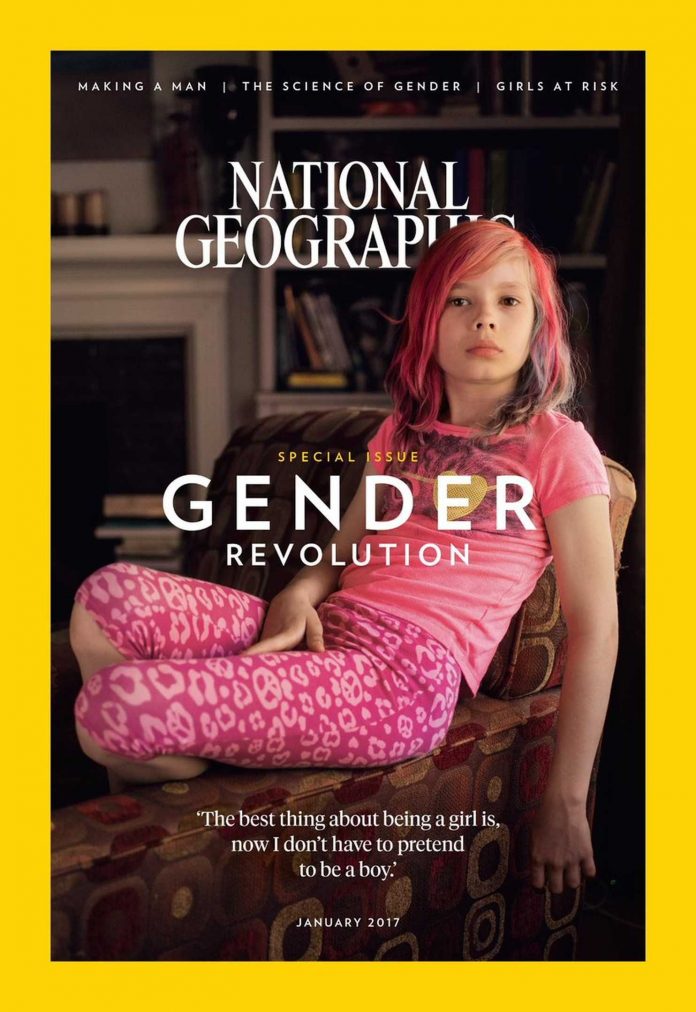
On Friday, National Geographic revealed the cover of its upcoming January magazine, a special issue devoted to gender. The child on the cover is Avery Jackson, a 9-year-old transgender girl from Kansas City.
“The best thing about being a girl is, now I don’t have to pretend to be a boy,” Avery says in the cover quote.
Susan Goldberg, National Geographic’s editor-in-chief, wrote in a recent editor’s note that reactions to the magazine cover were as diverse as “expressions of pride and gratitude to utter fury.” Goldberg embedded two tweets, capturing the general discourse on social media: Kudos, said one, for sharing Avery’s story. “National Geographic is trying to brainwash young people into thinking this kind of degeneracy is normal,” said the other.
Another Twitter critic lamented that National Geographic was supporting “child abuse.”
Many commented on the young age of Avery, who was assigned male at birth but has lived socially as a girl since she turned 5. “We’re cheering on Avery Jackson, a 9-year-old transgender girl,” wrote LGBT advocacy organization Freedom For All USA.
“In children, gender solidifies at about 3 to 6,” Johns Hopkins Children’s Center psychiatrist Patrick Kelly told The Washington Post in 2012.
Though quite rare, children are able to experience gender dysphoria, which the American Psychiatric Association describes as severe unease or conflict with assigned, expected gender roles and a person’s identity. The age when parents should support a child’s desire to socially transition – such as wearing clothes or using the bathroom of the child’s preferred gender – may be difficult to determine. (As the APA notes on its website, “medical transition is only relevant at and after the onset of puberty.”)
Just how early a parent could tell was the “million-dollar question,” said Diane Ehrensaft, a San Francisco-area developmental psychologist who has helped a few of her young patients transition to a new gender, in an interview with NPR in 2008.
“I think it’s a really complicated unfolding phenomenon,” Ehrensaft said. “I would say I never feel totally confident. But I think that if we really listen to the children, for some children you can know as early as pre-school.”
A February 2014 profile of Avery in the Kansas City Star recounted a conversation between a then-6-year-old Avery and Caroline Gibbs, a clinical counselor and director of the Transgender Institute in Missouri. Gibbs began, according to Avery’s mother:
“Can you tell me something about yourself? Are you a boy or a girl?”
“I’m a girl, ” A.J. said.
“What makes you think you’re a girl?”
“I just am, ” she said.
“Is it what you wear or what you play with?”
“No. I just am, ” she said.
“Your parents say ‘my son’ and ‘him.’ How does that make you feel?”
“I’m really a she,” A.J. responded, ” ’cause I’m a girl. I’m a daughter.”
Avery was able to capture “the complexity of the conversation around gender,” Goldberg wrote. “We thought that, in a glance, she summed up the concept of ‘Gender Revolution.'”
She also joins a number of transgender women featured on magazine covers in recent years. In 2014, actress Laverne Cox became the first transgender woman on the cover of Time. And in 2015, a Vanity Fair cover marked the public debut of Caitlyn Jenner. During the summer, Women’s Running July issue featured veteran marathoner Amelia Gapin, one of the first transgender women to grace the cover of a fitness magazine.
“Running helped me get through the mental and emotional struggles I went through while I was transitioning,” Gapin told People. “I was able to clear my head and approach things from a much better perspective.”
Avery’s cover photo marked a first for National Geographic, too. Past covers include celebrity explorers like James Cameron and scientists like Jane Goodall, though no transgender men or women before Avery.
The special January issue focuses “mostly on young people and how gender roles play out around the world,” Goldberg said in the announcement letter, writing that “beliefs about gender are shifting rapidly and radically. That’s why we’re exploring the subject this month, looking at it through the lens of science, social systems, and civilizations throughout history.”
This issue would not be the only time that a National Geographic cover photograph captured the public’s attention far beyond the newsstand. The June 1985 cover, a portrait of a refugee girl with piercing green eyes known for many years only as Afghan Girl, left a legacy that inspired a television documentary and a Finnish symphonic metal song.
(c) 2016, The Washington Post · Ben Guarino

